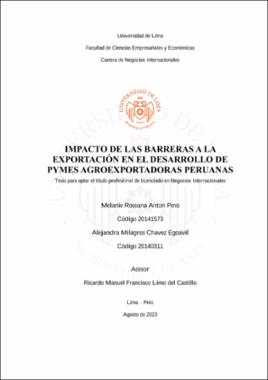Mostrar el registro sencillo del ítem
Impacto de las barreras a la exportación en el desarrollo de Pymes agroexportadoras peruanas
| dc.contributor.advisor | Limo Del Castillo, Ricardo Manuel Francisco | |
| dc.contributor.author | Anton Pino, Melanie Rossana | |
| dc.contributor.author | Chavez Egoavil, Alejandra Milagros | |
| dc.date.accessioned | 2023-11-15T12:58:32Z | |
| dc.date.available | 2023-11-15T12:58:32Z | |
| dc.date.issued | 2023 | |
| dc.identifier.citation | Anton Pino, M. R. & Chavez Egoavil, A. M. (2023). Impacto de las barreras a la exportación en el desarrollo de Pymes agroexportadoras peruanas [Tesis para optar el Título Profesional de Licenciado en Negocios Internacionales, Universidad de Lima]. Repositorio Institucional de la Universidad de Lima. https://hdl.handle.net/20.500.12724/19270 | es_PE |
| dc.identifier.uri | https://hdl.handle.net/20.500.12724/19270 | |
| dc.description.abstract | En la actualidad, muchas de las pequeñas y medianas empresas en el rubro agroexportador no desarrollan sus operaciones en el mercado internacional debido a que existen diversos tipos de barreras a la exportación que dificultan este proceso. Según Malca y Rubio (2015), existen cuatro tipos de barreras a la exportación que son: barreras de procedimiento, barreras de recursos, barreras de conocimiento y barreras exógenas. El presente trabajo identifica diferentes tipos de barreras a la exportación desde el punto de vista de diversos autores, tomando como referencia base a Oscar Malca. Asimismo, se analizan estudios previos realizados a Pymes alrededor del mundo, logrando observar las diferentes situaciones que se presentan. Adicional a ello, se describen distintas teorías basadas en el comercio internacional como la teoría de Adam Smith, el modelo Ricardiano, el modelo de Heckscher-Ohlin, entre otros. Si bien existen estudios previos a Pymes alrededor del mundo, son muy pocos los estudios realizados a aquellas dentro del territorio latinoamericano que permita replantear nuevas políticas o incentivos que les permita desarrollar su crecimiento. Los resultados muestran que para las pequeñas y medianas empresas agroexportadoras peruanas entrevistadas, la falta de conocimiento sobre el potencial del mercado de exportación y de conocimiento de oportunidades en un país extranjero es una barrera de conocimiento a la que se le debe dar mayor importancia. Asimismo, la falta de personal técnico en el extranjero y la insuficiente capacidad de producción de la empresa son unas de las barreras más importantes respecto a los recursos. Respecto a las barreras de procedimiento, se identificó que las barreras más importantes a las dificultades logísticas y a la documentación y trámites requeridos. Finalmente, el tipo de cambio es considerada por los encuestados, la barrera exógena más importante. | es_PE |
| dc.description.abstract | Nowadays, many of the small and medium-sized companies in the agro-export sector are unable to expand their products in the international market because there are many types of export barriers that make this process difficult. According to Malca and Rubio (2015), there are four types of export barriers: procedural barriers, resource barriers, knowledge barriers, and exogenous barriers. This paper identifies different types of export barriers from the point of view of various authors, based on Oscar Malca. Likewise, previous studies carried out on SMEs around the world are analyzed, managing to observe the different situations that arise. In addition to this, different theories based on international trade are described, such as the Adam Smith theory, the Ricardian model, the Heckscher-Ohlin model, among others. Although there are previous studies on SMEs around the world, there are very few studies carried out on those within the Latin American territory that allow rethinking new policies or incentives that allow them to develop their growth. The results obtained shows that for the Peruvian agro-exporting SMEs surveyed, the lack of knowledge of the potential of export markets and/or the lack of knowledge of opportunities abroad is a knowledge barrier that should be given greater importance. The lack of technical personnel abroad and the company's insufficient production capacity are considered the most important resource barriers. Logistical difficulties and/or documentation and paperwork required are also identified as the most important procedural barrier. Finally, the exogenous barrier considered the most important by those surveyed is the exchange rate. | es_PE |
| dc.format | application/pdf | es_PE |
| dc.language.iso | spa | es_PE |
| dc.publisher | Universidad de Lima | es_PE |
| dc.rights.uri | https://creativecommons.org/licenses/by-nc-sa/4.0/ | |
| dc.source | Repositorio Institucional - Ulima | es_PE |
| dc.source | Universidad de Lima | es_PE |
| dc.subject | Pequeñas y medianas empresas | es_PE |
| dc.subject | Industria agrícola | es_PE |
| dc.subject | Exportación | es_PE |
| dc.subject | Perú | es_PE |
| dc.subject | Small business | es_PE |
| dc.subject | Agricultural industries | es_PE |
| dc.subject | Exports | es_PE |
| dc.subject.classification | Negocios internacionales / Inteligencia de mercado | es_PE |
| dc.title | Impacto de las barreras a la exportación en el desarrollo de Pymes agroexportadoras peruanas | es_PE |
| dc.title.alternative | Impact of export barriers on the development of Peruvian Agri SME exporters | es_PE |
| dc.type | info:eu-repo/semantics/bachelorThesis | |
| thesis.degree.discipline | Negocios Internacionales | es_PE |
| thesis.degree.grantor | Universidad de Lima. Facultad de Ciencias Empresariales y Económicas | es_PE |
| thesis.degree.level | Título profesional | es_PE |
| thesis.degree.name | Licenciado en Negocios Internacionales | es_PE |
| dc.publisher.country | PE | es_PE |
| dc.subject.ocde | https://purl.org/pe-repo/ocde/ford#5.08.04 | |
| renati.author.dni | 71558903 | |
| renati.author.dni | 78008752 | |
| renati.advisor.orcid | https://orcid.org/0000-0002-1986-8542 | |
| renati.advisor.dni | 7576644 | |
| renati.juror | Guadalupe Butrón, Carlos Ricardo | |
| renati.juror | Limo del Castillo, Ricardo Manuel Francisco | |
| renati.juror | Arteaga Donayre, William Alfredo | |
| renati.level | http://purl.org/pe-repo/renati/level#tituloProfesional | |
| renati.type | https://purl.org/pe-repo/renati/type#tesis | |
| renati.discipline | 416116 | |
| ulima.lineadeinvestigacion | 5306 – 3.b20 | |
| ulima.cat | 015 |
Ficheros en el ítem
Este ítem aparece en la(s) siguiente(s) colección(ones)
-
Tesis [47]





